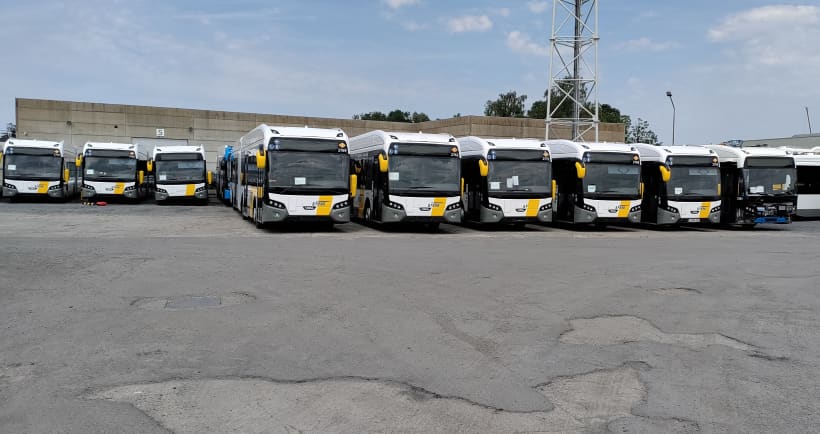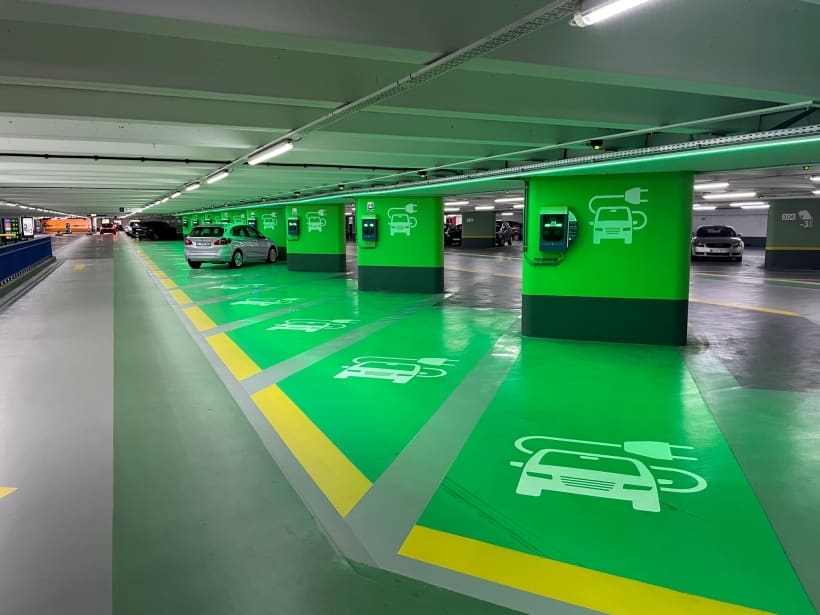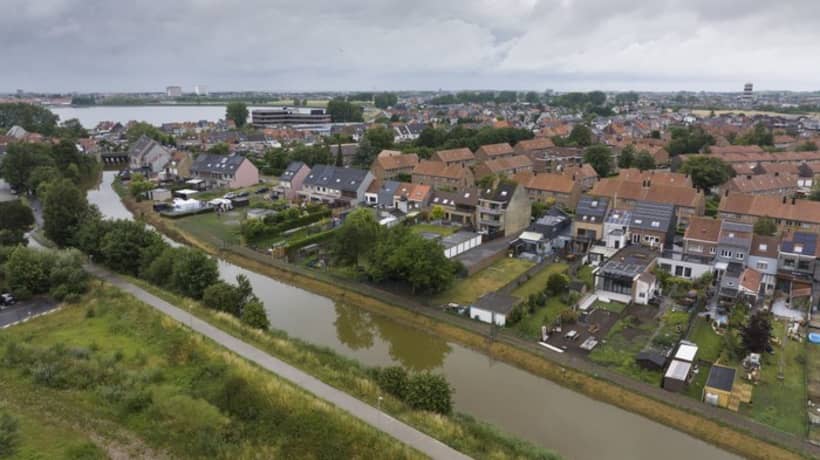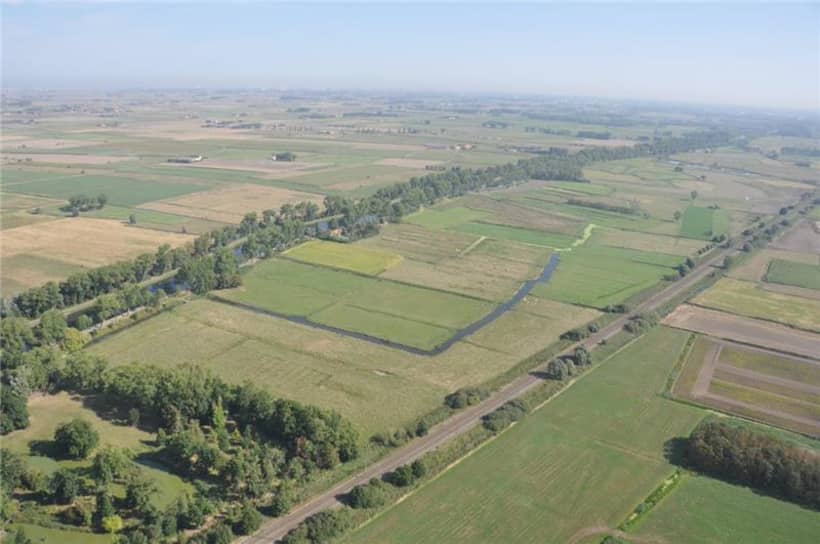Towards a sustainable Flanders
The Government of Flanders is investing Flemish Resilience funds totalling EUR 1.6 billion to save energy, reduce CO2 emissions, and tackle the water problem. For a resilient Flanders with a sustainable economy and society.

Thanks to the electric buses, De Lijn uses 40% less diesel.
De Lijn’s green bus fleet

Transport company De Lijn is further expanding its green and sustainable bus fleet. By the end of 2022, EUR 93 million in recovery funds will have been invested to convert 280 hybrid buses to plug-in e-hybrid buses. Forty-four articulated e-hybrid buses and sixty e-buses have also been ordered that will be put into service starting in 2023.
Kurt Gyselinck, De Lijn Programme Manager explains, ‘The electric buses do not have a classic combustion engine running on fossil fuels, but instead they have an electric engine and batteries that you recharge with electricity, which means they do not emit harmful substances such as CO2 and fine particles. Thanks to the electric buses, De Lijn uses 40% less diesel.’
Because De Lijn only buys green electricity, no emissions are generated to produce the energy. The depots are already undergoing construction to adapt them and De Lijn ordered 102 chargers, so that the e-buses can be charged at their stands.
Read more about De Lijn’s e-buses (in Dutch)(opens in new window).
More e-buses mean less CO2. Check out the dashboard (in Dutch), via which the Flemish public administration is monitoring the recovery and the key indicators that the recovery plan aims to have a direct/indirect impact on, with a focus on sustainable growth: Share of renewable energy (in Dutch) and Greenhouse gas emissions (in Dutch).
Charging points

To make the transition to electric driving possible, the Government of Flanders is expanding the charging infrastructure in Flanders. Recovery funds totalling EUR 30 million were used to install an additional 5,798 charging points. Flanders now has over 12,000 charging points. Many more will be added as from 2023 onwards.
The more cars and trucks that run on green electricity, the lower the CO2 emissions. The recovery plan aims to have a direct/indirect impact on the key indicators Share of renewable energy (in Dutch) and Greenhouse gas emissions (in Dutch).
A larger and safer cycling network

The Government of Flanders wants to get more people into cycling and is investing in a larger and safer cycling network. ‘Thanks to Flemish Resilience, we can construct new cycling paths, cycling bridges, and tunnels and improve the existing ones. We are redesigning intersections, completing bicycle highways and equipping junctions with bicycle parking racks,’ says Yanick Bos of the Department for Mobility and Public Works. The Government of Flanders is investing EUR 250 million of recovery funds in cycling infrastructure.
Over 70 kilometres of cycling paths have already been upgraded and 140 kilometres are undergoing improvement works. Another 257 kilometres will be addressed in the next phase.
Yanick Bos explains, ‘By the end of 2022, the concrete slab cycling path in Koksijde and Nieuwpoort will be replaced by a comfortable asphalt cycling path, and new cycling paths will be built. Over the next few years, 10 kilometres of new cycling paths will be added in Dilsen-Stokkem; a cycling path in Vilvoorde which links up with the bicycle highway will be improved; and cycling paths will be reconstructed and an intersection will be reorganised in Erpe-Mere - Lede.’
More cyclists on better cycling paths reduces road accidents, traffic jams, and CO2 emissions. Check out the dashboard (in Dutch), via which the Flemish public administration is monitoring the recovery and the key indicators that the recovery plan aims to have a direct/indirect impact on, with a focus on sustainable growth: Share of renewable energy (in Dutch), Greenhouse gas emissions (in Dutch), Traffic jam severity (in Dutch), and Road accidents (in Dutch).
Home batteries
The Government of Flanders encourages users of solar panels to use home batteries. It has already paid more than 13,000 grants for home batteries using Flemish and European recovery funds.
‘You can store the electricity generated by solar panels in a home battery and use it when the sun is not shining,’ says Kris Ronge of the Energy and Climate Agency of Flanders (VEKA). ‘In this way, you can increase your self-consumption of solar power from an average of 30% to 60% and more.’
Given the rising electricity prices, this is a worthwhile investment. The Government of Flanders wants to pay another 17,000 grants for home batteries.
More information and grant requests (in Dutch) (in Dutch).
The more renewable energy, the less CO2. Check out the key indicators that the recovery plan aims to have a direct/indirect impact on, with a focus on sustainable growth: Share of renewable energy (in Dutch) and Greenhouse gas emissions (in Dutch).
Blue Deal: a response to water nuisance and flood risk
We have had several extremely dry months in recent years, as well as extreme rainfall and flooding. With the Blue Deal, the Government of Flanders is making Flanders resilient to drought and flooding; it is a complete set of measures, worth EUR 354 million in recovery funds, which must ensure that water is better absorbed and retained in the soil.
According to Raf Nilis, Project Manager at the Flemish Land Agency (VLM), ‘We are reopening watercourses such as the IJse in Overijse, so that they get more space again. After all, water in an open watercourse is retained longer, which can be useful in times of drought. We also remove the asphalt so that the rainwater can seep into the soil again and the groundwater level will increase. The depaved areas are sown with a mix of grass and flowers.’
The Flemish administration purchased 150 hectares of land to make it possible to rewet areas.
‘Near the rear port of Zeebrugge, the Flemish administration made voluntary purchases and land swaps to convert 45 hectares in the Kwetshagezwin into reed marsh. The location and water-level management in the main watercourse of the area hinder an optimal rewetting of the project area,’ explains Edgard Daemen, Project Manager at the Flemish Land Agency (VLM). ‘With the Blue Deal project, we can move the watercourse to the edge of the project area, creating a reed marsh. This wetland retains the maximum amount of rainwater, which causes the area to be rewetted and allows us to preserve the flood buffer in periods of heavy rainfall. This will even create extra flood capacity: a higher water level to combat desiccation and additional buffer capacity to better cope with the heavier rainfall that we can expect in the future. Talk about climate adaptation.’
The Flanders Environment Agency (VMM) is carrying out work on watercourses and canals in the Demer valley’s Schulensbroek flood area so that more water can flow through the area.
Furthermore, the Government of Flanders stimulates (agricultural) businesses to invest in innovative and water-saving technologies. They can receive recovery funds for this as financial support.

Protection against flooding
Increasingly more buildings in Flanders are prone to flooding due to climate change. Therefore, the Government of Flanders is taking measures to protect these areas against flooding and water nuisance. For example, the Flanders Environment Agency (VMM) built a 500-metre protection dike (in Dutch)(opens in new window) along the Noordede in Ostend to protect 40 houses from flooding. The VMM also deepened and widened the Berwijn in Moelingen (in Dutch)(PDF file opens in new window) to reduce the risk of flooding.
The recovery plan aims to have a direct/indirect impact on the key indicators Water nuisance and flood risk (in Dutch) and Groundwater level (in Dutch).

